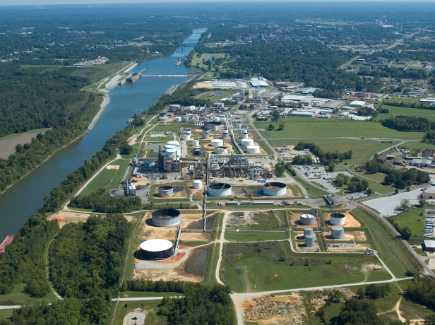

Have you ever considered how many hazardous materials (Hazmat) are in your community? It may shock you if you looked into it. The majority of communities across the U.S. have businesses that are storing, transporting, manufacturing, or utilizing Hazmat. If accidentally released into the community, they could cause significant harm and damage to life and property. In 1986, congress passed the Emergency Planning and Community Right-to-Know Act (EPCRA) to create transparency regarding the hazardous and toxic chemicals present in communities across the country. In 2018, the EPCRA was amended with the addition of the “America’s Water Infrastructure Act” (AWIA) that requires state and tribal emergency response commissions to notify the applicable state agencies (including water agencies) of any Hazmat release that may affect drinking water sources.
With the AWIA now in place, the EPCRA provides an adequate baseline set of standards for communities to build emergency preparedness and resiliency against Hazmat risks. However, we’ve found that many communities still lack the funding, know-how, and/or human resources to develop, write, and implement an effective Emergency Response Plan that has “whole community” buy-in and support. Additionally, many Local Emergency Planning Committees (LEPCs) struggle to implement all the EPCRA requirements effectively.
As communities work to figure out how to become compliant with the new AWIA requirements, we want to help. This blog will cover “5 Best Practices” for designing, writing, and implementing an effective Emergency Response Plan with whole community engagement that exceeds the expectations outlined in the EPCRA. These 5 best practices come from years of experience conducting community-wide hazard risk assessments and helping LEPCs write or update their Emergency Response Plans.
ASG’s “5 Best Practices and Tips” for developing and implementing effective ERPs:
-
Build Whole Community Involvement
You’ve heard the term “All Y’all” before? The term “Whole Community” is similar. A bit redundant, but necessary for the intended purpose. For an ERP to be effective, you must cultivate an “all ya’ll” buy-in; or whole community buy-in and engagement from the beginning. This requires including all stakeholders in the community, both from public and private sectors, at appropriate points in the ERP design and implementation. The LEPC is the gateway for this cultivation, but there are often unknown or unidentified stakeholders in the community that need to be brought into the process. Each year when updating the ERP, be sure to thoroughly look for new stakeholders that need a seat at the table. -
Make the ERP “Actionable”
While lists of Extremely Hazardous Substance (EHS) facilities are helpful, they don’t aid in visualizing their physical locations. The ERP should be useful for both planning and response purposes. Plotting the EHS facilities in a Geographic Information System (GIS) enables emergency planners to easily visualize where these facilities are in relation to vulnerable facilities (e.g., hospitals, schools, etc.) in a community making the ERP much more user friendly and helpful. -
Include Transportation Routes and Modeling
It’s a bird! It’s a plane! No. It’s a train? Highways, airports, railways, and water systems are modes used to transport Hazmat through communities. It is imperative to determine the types and quantities of Hazmat being transported through communities and the proximity of the transportation routes to vulnerable facilities. Incorporating explosive modeling along these transportation routes in a GIS provides an extra level of understanding the risks to your community. -
Practice and Validate
We have found that ERPs are typically known well by only a small portion of the LEPC that was involved in its development. Many stakeholders haven’t had the opportunity to thoroughly familiarize themselves with the plan. We recommend running a half-day seminar with all stakeholders to thoroughly cover the ERP, clear up any misunderstandings, and make sure everyone knows the plan. Next, we recommend following up the half-day seminar with a half-day Tabletop Exercise (TTX) with all stakeholders involved to validate the ERP. The TTX will identify areas of strength and areas for improvement for the LEPC. If done every year, the full-day program of an ERP seminar and TTX will ensure any new stakeholders are familiar with the ERP, which adds to whole community preparedness and resilience. -
Include New AWIA Requirements
If LEPCs have not yet included the new AWIA requirements into their ERPs, now is the time. Drinking water systems are lifelines for communities. Communities are devastated when water sources are contaminated. Recent events have shown how hackers or criminals can access water system networks and potentially poison a community’s drinking water. In communities across the country, there are chemical plants, oil storage facilities, and industrial complexes near drinking water sources. The ERP must be updated with thorough planning to mitigate the Hazmat risks to water sources.


The recent fire at the Chemtool Hazmat facility in Rockton, Ill. on June 14 shows just how significant the impact of a Hazmat incident can be on a community. This incident evacuated over 1500 people in the surrounding areas and closed down the major interstate for eight hours. Cities across the country have similar Hazmat facilities, and risks like this are present in each community. LEPCs should make sure their communities have updated and effective Hazmat ERPs in place to build whole-community preparedness and resilience.
Aboug ASG
ASG has been at the forefront of building community-wide emergency preparedness capabilities for over 16 years, having conducted more than 80 all-hazards, risk-based emergency response plans for organizations and communities around the globe. In the past several years, ASG has supported various LEPCs through developing, writing, and implementing their ERP. We then follow up by developing the annual review and update to existing ERPs. These efforts have helped LEPCs update their ERPs to comply with the new AWIA requirements. Through the countless hours of perfecting our approach, you can say we’ve “mastered the process”.
For a practical next step, we recommend all stakeholders in LEPCs take our Whole Community Engagement for Hazmat Planning course. We can provide the course through an in-person, live (virtual webinar) or online (flexible delivery through our online learning management system). We can provide customized pricing options based on your LEPC’s or state’s needs.
Contact us at instructor@asg-inc.org or call us at 757-223-7233.

